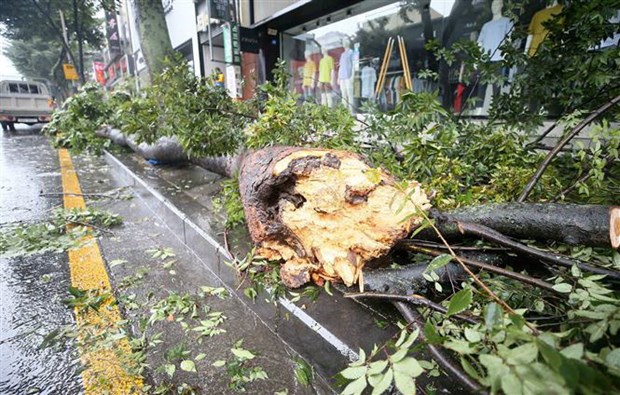
Trees fell after storm Bavi made landfall on Jeju Island, South Korea, on August 26, 2020. (Photo: Yonhap / VNA)
North Korean media said on August 27 that typhoon Bavi landed in the country, knocked out trees and caused flooding and other damage. According to state television, typhoon Bavi brought heavy rain and strong winds that caused landslides, knocked down many trees, electric poles, caused widespread flooding, damaged homes and many other structures in the towns along the west coast of this country. The port city west of Nampo was one of the areas most affected when roads and vehicles were submerged in flood waters. According to forecasts, the storm is continuing to strengthen and is believed to be more powerful than Typhoon Lingling that destroyed many areas of the country in September 2019. Earlier, North Korea had ordered the relocation of ships along the west coast to a safe haven and closely monitored key industrial facilities to minimize damage.
Leader Kim Jong-un on August 25 hosted an important meeting of the Politburo of the Korean Labor Party, which discussed measures to respond to typhoon Bavi. Before landing in North Korea, typhoon Bavi swept through southern Korea on August 26, causing widespread power outages and destruction of properties. According to the Korea Meteorological Agency (KMA), typhoon Bavi with the strongest winds of up to 32 meters per second, damaged more than 100 structures, causing power outages for more than 1,600 households, mainly in the coastal areas. South, including Jeju Island and Chungcheong Province. The Korean Ministry of Agriculture, Food and Rural Affairs said 513 hectares of arable land had been destroyed, requiring Korea to work hard to recover the damage from the storm. The storm warning order has been lifted now, but heavy rain is expected to continue in Seoul and North and South Gyeongsang provinces.
Due to the influence of Hurricane Bavi, 438 flights at 11 airports, about 160 ferries were canceled and many other traffic was interrupted. More than 1,400 employees of the rescue force were mobilized to handle the damage and implement safety measures. Faced with the danger that storm Bavi could bring heavy rain and heavy winds into the Northeastern region of China, the country's National Meteorological Center on August 27 morning issued a red warning, the highest level in the storm warning system. There are four levels (from green, yellow, orange to red). Hurricane Bavi caused many localities in northeastern China to close schools and suspend transport operations. Jilin province has implemented emergency response measures, in which Changchun City (capital of Jilin province) requested temporary closure of schools and suspension of flights and trains in the area until when safe ./.